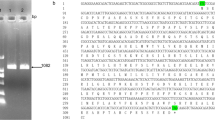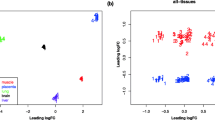Abstract
The productivity of beef cows depends on early reproduction traits such as puberty and has an economic impact on the efficiency of production system. Imprinted genes modulate many important endocrine processes such as growth, the onset of puberty and maternal reproductive and behavior. The role of imprinted genes in puberty is a challenging subject since they show the reciprocal role of maternal and paternal genomes in progeny. Although, there are evidences of the involvement of imprint genes in puberty in human, the role of this type of genes in the onset of puberty in cattle has not been studied yet. Here we examined the expression of 27 imprinted genes in pre and post puberty in a bovine model to find differentially expressed imprinted genes in maternal-paternal purebreds and reciprocal crosses across eight tissues and discussed the task of these genes in this crucial process of development and in onset of puberty. DLK1 and MKRN3 that previously described as cause of the central precocious puberty (CPP) in human were differentially expressed in this study. Functional annotation analysis of differentially imprinted genes in different tissues showed significant biological processes of cellular response to growth factor stimulus, response to growth factor, response to parathyroid hormone, developmental growth and the importance of alternative splicing. The results of this study have implications in understanding the role of imprinted genes in the onset of puberty in cattle.




Similar content being viewed by others
References
Abreu AP, Kaiser UB (2016) Pubertal development and regulation. Lancet Diabetes Endocrinol 4(3):254–264
Abreu AP, Dauber A, Macedo DB, Noel SD, Brito VN, Gill JC, Cukier P, Thompson IR, Navarro VM, Gagliardi PC (2013) Central precocious puberty caused by mutations in the imprinted gene MKRN3. N Engl J Med 368:2467–2475
Afgan E, Baker D, Batut B, Van Den Beek M, Bouvier D, Čech M, Chilton J, Clements D, Coraor N, Grüning BA (2018) The Galaxy platform for accessible, reproducible and collaborative biomedical analyses: 2018 update. Nucleic Acids Res 46:W537–W544
Baralle FE, Giudice J (2017) Alternative splicing as a regulator of development and tissue identity. Nat Rev Mol Cell Biol 18(7):437–451
Brionne A, Juanchich A, Hennequet-Antier C (2019) ViSEAGO: a bioconductor package for clustering biological functions using gene ontology and semantic similarity. BioData Min 12(1):1–13
Cánovas A, Reverter A, DeAtley KL, Ashley RL, Colgrave ML, Fortes MR, Islas-Trejo A, Lehnert S, Porto-Neto L, Rincón G, Silver GA, Thomas MG (2014) Multi-tissue omics analyses reveal molecular regulatory networks for puberty in composite beef cattle. PLoS ONE 9(7):e102551
Cao G, Liu Q, Chu M, Di R, Fang L, Feng T, Li N (2013) Analysis on cDNA sequence, alternative splicing and polymorphisms associated with timing of puberty of Lin28B gene in goats. Mol Biol Rep 40:4675–4683
Charalambous M, Smith FM, Bennett WR, Crew TE, Mackenzie F, Ward A (2003) Disruption of the imprinted Grb10 gene leads to disproportionate overgrowth by an Igf2-independent mechanism. Proc Natl Acad Sci 100:8292–8297
Chen Z, Hagen DE, Wang J, Elsik CG, Ji T, Siqueira LG, Hansen PJ, Rivera RM (2016) Global assessment of imprinted gene expression in the bovine conceptus by next generation sequencing. Epigenetics 11:501–516
Curley J, Pinnock S, Dickson S, Thresher R, Miyoshi N, Surani M, Keverne E (2005) Increased body fat in mice with a targeted mutation of the paternally expressed imprinted gene Peg3. FASEB J 19:1302–1304
Dauber A, Cunha-Silva M, Macedo DB, Brito VN, Abreu AP, Roberts SA, Montenegro LR, Andrew M, Kirby A, Weirauch MT (2017) Paternally inherited DLK1 deletion associated with familial central precocious puberty. J Clin Endocrinol Metab 102:1557–1567
DeChiara TM, Robertson EJ, Efstratiadis A (1991) Parental imprinting of the mouse insulin-like growth factor II gene. Cell 64:849–859
Erdmann VA, Szymanski M, Hochberg A, Groot ND, Barciszewski J (2000) Non-coding, mRNA-like RNAs database Y2K. Nucleic Acids Res 28(1):197–200
Grandone A, Capristo C, Cirillo G, Sasso M, Umano GR, Mariani M, Del Giudice EM, Perrone L (2017) Molecular screening of MKRN3, DLK1, and KCNK9 genes in girls with idiopathic central precocious puberty. Horm Res Paediatr 88:194–200
Howard SR (2019) The genetic basis of delayed puberty. Front Endocrinol 10:423
Huang DW, Sherman BT, Lempicki RA (2009) Systematic and integrative analysis of large gene lists using DAVID bioinformatics resources. Nat Protoc 4(1):44–57
Ioannides Y, Lokulo-Sodipe K, Mackay DJ, Davies JH, Temple IK (2014) Temple syndrome: improving the recognition of an underdiagnosed chromosome 14 imprinting disorder: an analysis of 51 published cases. J Med Genet 51:495–501
Isles AR, Davies W, Wilkinson LS (2006) Genomic imprinting and the social brain. Phil Trans R Soc B 361:2229–2237
Kagami M, O’Sullivan MJ, Green AJ, Watabe Y, Arisaka O, Masawa N, Matsuoka K, Fukami M, Matsubara K, Kato F, Ferguson-Smith AC, Ogata T (2010) The IG-DMR and the MEG3-DMR at human chromosome 14q32 2: hierarchical interaction and distinct functional properties as imprinting control centers. PLoS Genet 6(6):e1000992
Karami K, Zerehdaran S, Javadmanesh A, Shariati MM (2019a) Assessment of maternal and parent of origin effects in genetic variation of economic traits in Iranian native fowl. Br Poult Sci 60:486–492
Karami K, Zerehdaran S, Javadmanesh A, Shariati MM, Fallahi H (2019b) Characterization of bovine (Bos taurus) imprinted genes from genomic to amino acid attributes by data mining approaches. PLoS ONE 14:e0217813
Kelberman D, Rizzoti K, Lovell-Badge R, Robinson IC, Dattani MT (2009) Genetic regulation of pituitary gland development in human and mouse. Endocr Rev 30(7):790–829
Kenny DA, Heslin J, Byrne CJ (2018) Early onset of puberty in cattle: implications for gamete quality and embryo survival. Reprod Fertil Dev 30(1):101–117
Kotler J, Haig D (2018) The tempo of human childhood: a maternal foot on the accelerator, a paternal foot on the brake. Evol Anthropol 27:80–91
Lee Y, Rio DC (2015) Mechanisms and regulation of alternative pre-mRNA splicing. Annu Rev Biochem 84:291–323
Li L-L, Keverne E, Aparicio S, Ishino F, Barton S, Surani M (1999) Regulation of maternal behavior and offspring growth by paternally expressed Peg3. Science 284:330–334
Li J, Shen H, Xie H, Ying Y, Jin K, Yan H, Wang S, Xu M, Wang X, Xu X, Xie L (2019) Dysregulation of ncRNAs located at the DLK1 DiO3 imprinted domain: involvement in urological cancers. Cancer Manag Res 11:777
Macedo DB, Brito VN, Latronico AC (2014) New causes of central precocious puberty: the role of genetic factors. Neuroendocrinology 100:1–8
Magee DA, Berry DP, Berkowicz EW, Sikora KM, Howard DJ, Mullen MP, Evans RD, Spillane C, MacHugh DE (2011) Single nucleotide polymorphisms within the bovine DLK1-DIO3 imprinted domain are associated with economically important production traits in cattle. J Hered 102(1):94–101
Masoudzadeh S, Mohammadabadi M, Khezri A, Kochuk-Yashchenko O, Kucher D, Babenko O, Bushtruk M, Tkachenko S, Stavetska R, Klopenko N (2020) Dlk1 gene expression in different tissues of lamb. Iran J Appl Anim Sci 10(4):669–677
McGrath J, Solter D (1984) Completion of mouse embryogenesis requires both the maternal and paternal genomes. Cell 37:179–183
Mechaly AS, Viñas J, Piferrer F (2009) Identification of two isoforms of the Kisspeptin-1 receptor (kiss1r) generated by alternative splicing in a modern teleost, the Senegalese sole (Solea senegalensis). Biol Reprod 80:60–69
Naulé L, Maione L, Kaiser UB (2021) Puberty, a sensitive window of hypothalamic development and plasticity. Endocrinology 162(1):bqaa209
Ojeda SR, Hill J, Hill DF, Costa ME, Tapia V, Cornea A, Ma YJ (1999) The Oct-2 POU domain gene in the neuroendocrine brain: a transcriptional regulator of mammalian puberty. Endocrinology 140:3774–3789
Palmert MR, Boepple PA (2001) Variation in the timing of puberty: clinical spectrum and genetic investigation. J Clin Endocrinol Metab 86(6):2364–2368
Pan X, Li Q, Chen D, Gong W, Li N, Jiang Y, Zhang H, Chen Y, Yuan X (2021) Alternative splicing dynamics of the hypothalamus–pituitary–ovary axis during pubertal transition in gilts. Front Genet. https://doi.org/10.3389/fgene.2021.592669
Park C-H, Uh K-J, Mulligan BP, Jeung E-B, Hyun S-H, Shin T, Ka H, Lee C-K (2011) Analysis of imprinted gene expression in normal fertilized and uniparental preimplantation porcine embryos. PLoS ONE 6:e22216
Pereira GR, Barcellos JOJ, Sessim AG, Tarouco JU, Feijó FD, Braccini J, Prates ÊR, Canozzi MEA (2017) Relationship of post-weaning growth and age at puberty in crossbred beef heifers. Revista Brasileira De Zootecnia 46:413–420
Perry JR, Day F, Elks CE, Sulem P, Thompson DJ, Ferreira T, He C, Chasman DI, Esko T, Thorleifsson G (2014) Parent-of-origin-specific allelic associations among 106 genomic loci for age at menarche. Nature 514:92–97
Peters J (2014) The role of genomic imprinting in biology and disease: an expanding view. Nat Rev Genet 15:517–530
Reik W, Walter J (2001) Genomic imprinting: parental influence on the genome. Nat Rev Genet 2:21–32
Roberts SA, Kaiser UB (2020) Genetics in endocrinology: Genetic etiologies of central precocious puberty and the role of imprinted genes. Eur J Endocrinol 183:R107–R117
Sánchez JM, Keogh K, Kelly AK, Byrne CJ, Lonergan P, Kenny DA (2021) A high plane of nutrition during early life alters the hypothalamic transcriptome of heifer calves. Sci Rep 11:1–13
Scagliotti V, Costa Fernandes Esse R, Willis TL, Howard M, Carrus I, Lodge E, Andoniadou CL, Charalambous M (2021) Dynamic expression of imprinted genes in the developing and postnatal pituitary gland. Genes 12:509
Spaziani M, Tarantino C, Tahani N, Gianfrilli D, Sbardella E, Lenzi A, Radicioni AF (2021) Hypothalamo-pituitary axis and puberty. Mol Cell Endocrinol 520:111094
Szklarczyk D, Gable AL, Lyon D, Junge A, Wyder S, Huerta-Cepas J, Simonovic M, Doncheva NT, Morris JH, Bork P, Jensen LJ, Mering CV (2019) STRING v11: protein–protein association networks with increased coverage, supporting functional discovery in genome-wide experimental datasets. Nucleic Acids Res 47(D1):D607–D613
Tahir MS, Porto-Neto LR, Gondro C, Shittu OB, Wockner K, Tan AW, Smith HR, Gouveia GC, Kour J, Fortes MR (2021) Meta-analysis of heifer traits identified reproductive pathways in bos indicus cattle. Genes 12:768
Terasawa E, Fernandez DL (2001) Neurobiological mechanisms of the onset of puberty in primates. Endocr Rev 22:111–151
Trivers RL (1974) Parent-offspring conflict. Integr Comp Biol 14:249–264
Xiang R, Ghanipoor-Samami M, Johns WH, Eindorf T, Rutley DL, Kruk ZA, Fitzsimmons CJ, Thomsen DA, Roberts CT, Burns BM (2013) Maternal and paternal genomes differentially affect myofibre characteristics and muscle weights of bovine fetuses at midgestation. PLoS ONE 8:e53402
Xiang R, Lee AM, Eindorf T, Javadmanesh A, Ghanipoor-Samami M, Gugger M, Fitzsimmons CJ, Kruk ZA, Pitchford WS, Leviton AJ (2014) Widespread differential maternal and paternal genome effects on fetal bone phenotype at mid-gestation. J Bone Miner Res 29:2392–2404
Acknowledgements
We thank Ferdowsi University of Mashhad for providing research facilities to conduct this study.
Funding
This study was funded by Ferdowsi University of Mashhad.
Author information
Authors and Affiliations
Contributions
KK: did the analysis and wrote the manuscript. SZ: check the results and wrote the manuscript. AJ: made some comments during analysis and writing the manuscript.
Corresponding authors
Ethics declarations
Conflict of interest
The authors declare no conflict of interest.
Additional information
Publisher's Note
Springer Nature remains neutral with regard to jurisdictional claims in published maps and institutional affiliations.
Supplementary Information
Below is the link to the electronic supplementary material.
Rights and permissions
Springer Nature or its licensor (e.g. a society or other partner) holds exclusive rights to this article under a publishing agreement with the author(s) or other rightsholder(s); author self-archiving of the accepted manuscript version of this article is solely governed by the terms of such publishing agreement and applicable law.
About this article
Cite this article
Karami, K., Zerehdaran, S. & Javadmanesh, A. Differential Expression of RNAseq Imprinted Genes from Bovine Females Before and After Puberty. Biochem Genet 61, 2633–2649 (2023). https://doi.org/10.1007/s10528-023-10395-9
Received:
Accepted:
Published:
Issue Date:
DOI: https://doi.org/10.1007/s10528-023-10395-9




